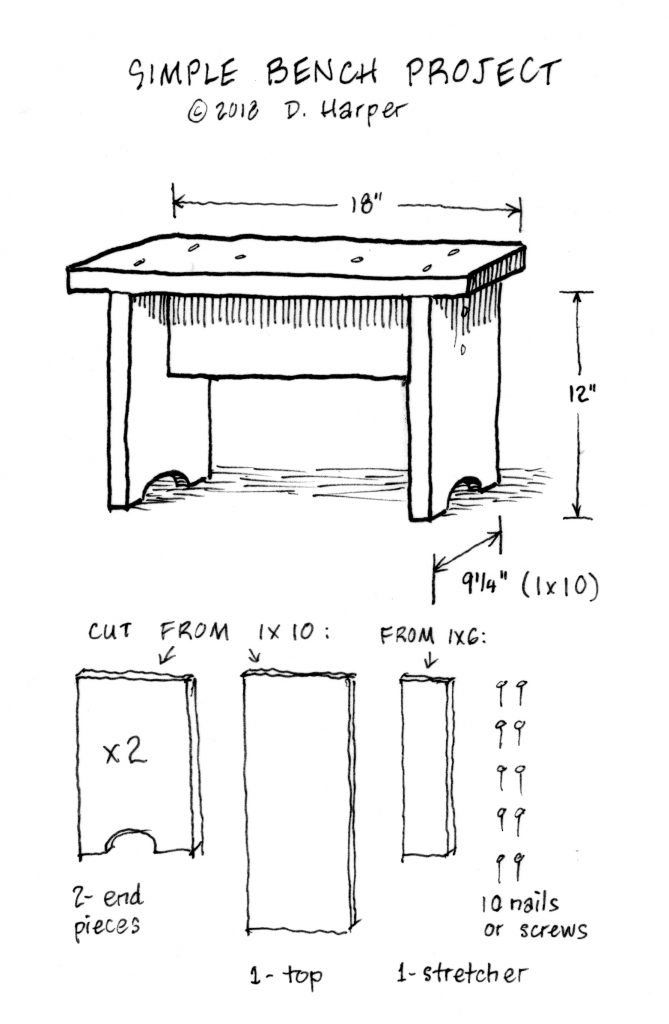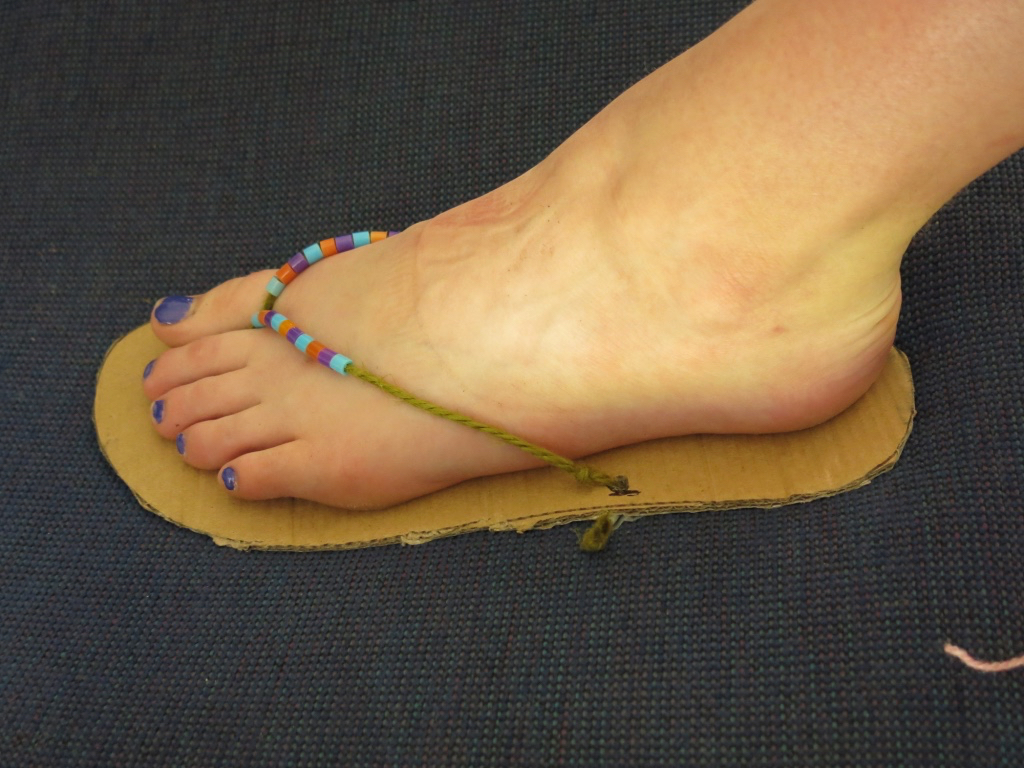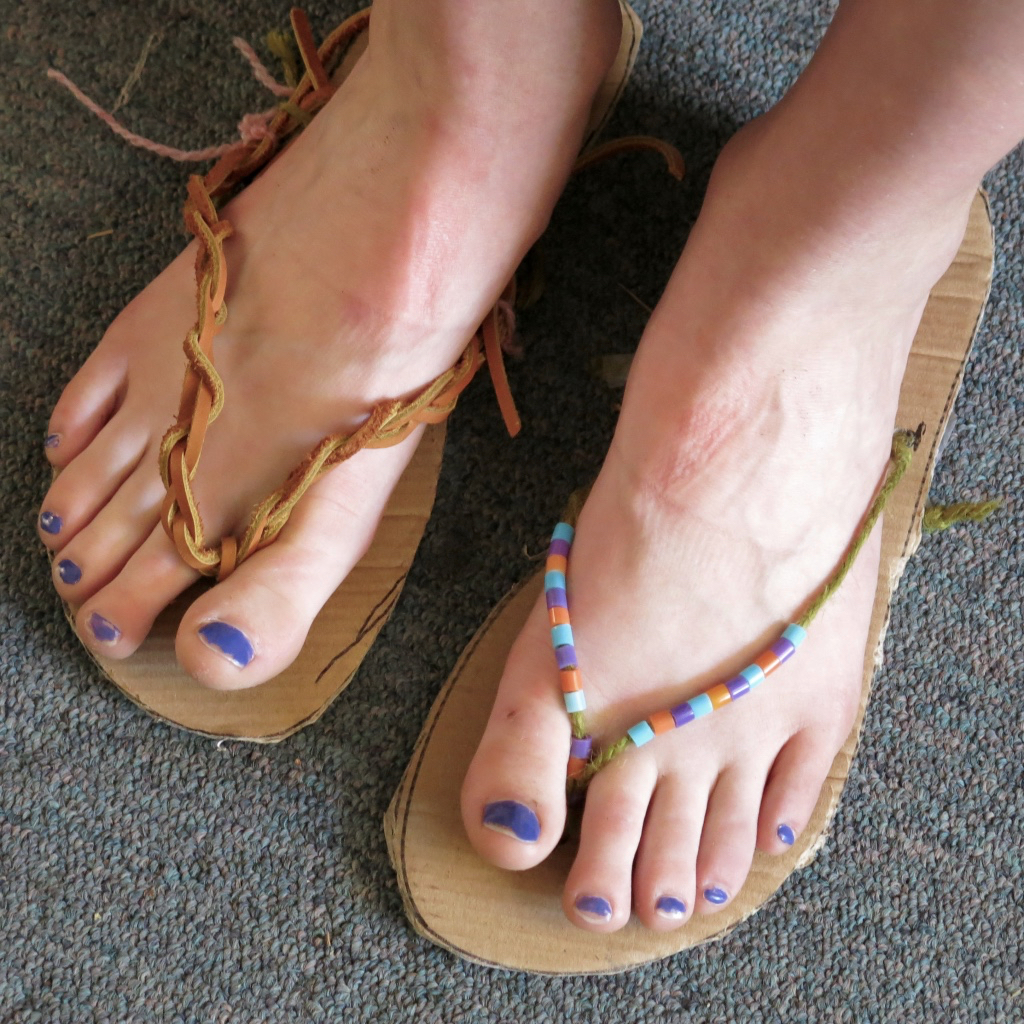Judean Village
A curriculum for mixed-age elementary grades by Dan Harper
Copyright (c) 2015-2018 Dan Harper
———
Carpenter
Herbal Salves and Potions Maker
Painter
Sandal Maker
Water Carrier
———
CARPENTER
We have experimented with several different woodworking projects. The best projects are those which result in a finished project at the end of the session. But the project can’t be too simple, or the kids get bored. Your project will be dictated in large part by the person you find to run this project — they will need to provide their own tools and they will need to do some prep work, so the project will have to fit in with whatever tools and skills they have.
A simple project that most elementary-age kids could complete in 30 minutes is this bench project:
The instructions that follow assume that you’re going to nail everything together. If you decide to use screws instead, make sure your pilot holes are big enough so that the kids will have the strength to screw things together, but not so big that the screws strip out.
Cut the pieces out ahead of time. (Make at least one set with the holes pre-drilled.) Make up jigs to hold the top in place while nailing it to the stretcher.
Have the apprentices do the following:
— Measure, mark, and drill pilot holes for the nails or screws. An egg-beater type drill works well with kids.
— Measure and mark where the stretcher should sit on the top.
— Place the top on the nailing jig, slide the stretcher in so it’s in the correct place. Nail the top on the stretcher.
— Put the end pieces in place, and nail them on one at a time. This is a two-person job: one person holds one end piece and the top, while the other person nails the other end piece in place. (Here again a jig would make things easier.)
— Nail the end pieces to the ends of the stretcher. Two nails per end are shown, you could get away with one if you’re short on time.
— Sand the completed project.
If you need to save time, you can do some of the measuring and marking in advance.
A great project for little kids is this simple wooden top.
Cultural and religious significance
The obvious point for the Carpenter to make to the apprentices is that Joseph, the father of Jesus, is a well-known carpenter. And the carpenter might want to wonder aloud why Jesus would stop working as a carpenter, since it’s such an important job.
After all, wasn’t Noah a carpenter when he made the ark?
And didn’t King Solomon have carpenters working for him who helped build the first great Temple? That’s what it says in 1 Kings 5:18: “Solomon’s builders worked with Hiram’s builders, accompanied by the Gebalites, to quarry the stone and to prepare the timber and other stone for the Temple’s construction.”
Clearly, carpentry is one of the most important jobs!
———
HERBAL SALVES AND POTIONS MAKER
For this village shop, we had someone who knew a good deal about herbal remedies. She worked on two projects with the apprentices: making an herbal salve for bruises, and making infusions of herbs in oil.
———
PAINTER
Contrary to what is often stated, not all ancient Jews banned representational art, and there were some painters in the ancient world who painted Jewish themes. The main example is the synagogue at the ancient city of Dura-Europos, in modern-day Syria, dated to about 200 C.E., which had frescoes on its walls depicting scenes and persons from the Hebrew Bible.
In this Judean Village activity, the “apprentices” get to make copies of some of the frescoes from the synagogue at Dura-Europos; making copies of the master’s works is a time-honored way of teaching apprentice artists. We have chosen three paintings from Dura-Europos that depict events from Moses’s life. This provides a great opportunity to briefly retell the stories behind these events, and to reinforce that the people in this Judean Village were Jews who would have known Moses’s life story.
The activity is simple:
— print out the images in color
— provide watercolor paints, pencils (for sketching outlines), paper, smocks
— briefly retell the stories
— help the “apprentices” to draw and paint the images on their own
For older children, remember that people in the Ancient Near East did not think of painters as inspired artists. Instead, painters were more like potters, decorative craftsmen (and they would have all been men) who used familiar designs over and over again. Thus, it is fine if the apprentices trace the paintings and then color them in. For younger children, you could even create coloring pages — outline drawings of each of these paintings that a younger child can simply color in.
———
1. Moses found by Pharaoh’s daughter in the bulrushes
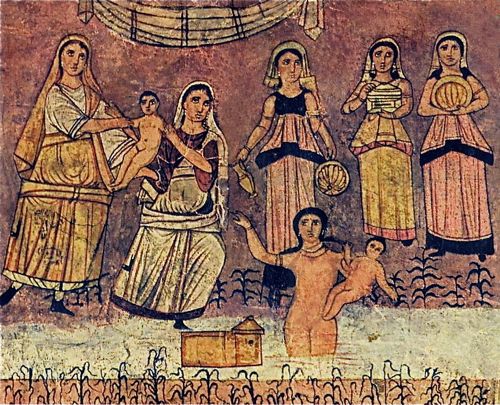
The story is in the Torah, Exodus 2.1-10:
“Now a man from the house of Levi went and married a Levite woman. The woman conceived and bore a son; and when she saw that he was a fine baby, she hid him three months. When she could hide him no longer she got a papyrus basket for him, and plastered it with bitumen and pitch; she put the child in it and placed it among the reeds on the bank of the river. His sister stood at a distance, to see what would happen to him.
“The daughter of Pharaoh came down to bathe at the river, while her attendants walked beside the river. She saw the basket among the reeds and sent her maid to bring it. When she opened it, she saw the child. He was crying, and she took pity on him, ‘This must be one of the Hebrews’ children,’ she said. Then his sister said to Pharaoh’s daughter, ‘Shall I go and get you a nurse from the Hebrew women to nurse the child for you?’ Pharaoh’s daughter said to her, ‘Yes.’ So the girl went and called the child’s mother. Pharaoh’s daughter said to her, ‘Take this child and nurse it for me, and I will give you your wages.’ So the woman took the child and nursed it. When the child grew up, she brought him to Pharaoh’s daughter, and she took him as her son. She named him Moses, ‘because,’ she said, ‘I drew him out of the water.'”
———
2. Moses and the burning bush
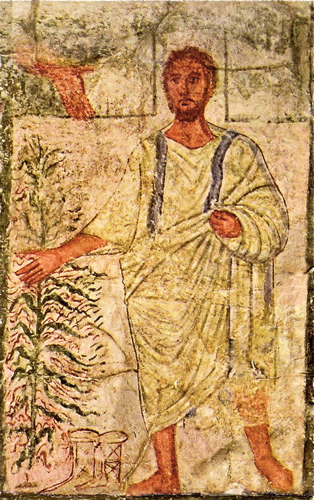
The story is in the Torah, Exodus 3.1-15, and tells how Yahweh, the god of the Israelites, called Moses to become a leader of his people and lead them out of bondage:
“Moses was keeping the flock of his father-in-law Jethro, the priest of Midian; he led his flock beyond the wilderness, and came to Horeb, the mountain of God. There the angel of the Lord appeared to him in a flame of fire out of a bush; he looked, and the bush was blazing, yet it was not consumed. Then Moses said, ‘I must turn aside and look at this great sight, and see why the bush is not burned up.’
“When the Lord saw that he had turned aside to see, God called to him out of the bush, ‘Moses, Moses!’
“And Moses said, ‘Here I am.’
“Then the Lord said, ‘Come no closer! Remove the sandals from your feet, for the place on which you are standing is holy ground.’ The Lord said further, ‘I am the God of your father, the God of Abraham, the God of Isaac, and the God of Jacob.’
“And Moses hid his face, for he was afraid to look at God.
“Then the Lord said, ‘I have observed the misery of my people who are in Egypt; I have heard their cry on account of their taskmasters. Indeed, I know their sufferings, and I have come down to deliver them from the Egyptians, and to bring them up out of that land to a good and broad land, a land flowing with milk and honey, to the country of the Canaanites, the Hittites, the Amorites, the Perizzites, the Hivites, and the Jebusites. The cry of the Israelites has now come to me; I have also seen how the Egyptians oppress them. So come, I will send you to Pharaoh to bring my people, the Israelites, out of Egypt.’
“But Moses said to God, ‘Who am I that I should go to Pharaoh, and bring the Israelites out of Egypt?’
“The Lord said, ‘I will be with you; and this shall be the sign for you that it is I who sent you: when you have brought the people out of Egypt, you shall worship God on this mountain.’
“But Moses said to God, ‘If I come to the Israelites and say to them, “The God of your ancestors has sent me to you,” and they ask me, “What is his name?” what shall I say to them?’
“God said to Moses, ‘I AM WHO I AM.’ He said further, ‘Thus you shall say to the Israelites, “I AM has sent me to you.”‘ God also said to Moses, ‘Thus you shall say to the Israelites, “The Lord, the God of your ancestors, the God of Abraham, the God of Isaac, and the God of Jacob, has sent me to you”: This is my name forever, and this my title for all generations.'”
———
3. Moses and the parting of the Read Sea
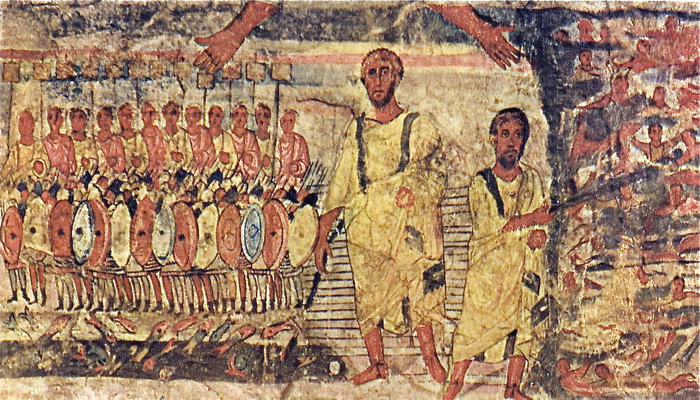
The story is in the Torah, Exodus 13.17-14.31. Pharaoh has finally allowed the Israelites to leave Egypt. But then he changes his mind, and pursues them into the desert. Moses appeals to Yahweh, the god of the Israelites, who tells Moses to lead the Israelites across the Red Sea:
“Then Moses stretched out his hand over the sea. The Lord drove the sea back by a strong east wind all night, and turned the sea into dry land; and the waters were divided. The Israelites went into the sea on dry ground, the waters forming a wall for them on their right and on their left. The Egyptians pursued, and went into the sea after them, all of Pharaoh’s horses, chariots, and chariot drivers.
“At the morning watch the Lord in the pillar of fire and cloud looked down upon the Egyptian army, and threw the Egyptian army into panic. He clogged their chariot wheels so that they turned with difficulty. The Egyptians said, ‘Let us flee from the Israelites, for the Lord is fighting for them against Egypt.’
“Then the Lord said to Moses, ‘Stretch out your hand over the sea, so that the water may come back upon the Egyptians, upon their chariots and chariot drivers.’
“So Moses stretched out his hand over the sea, and at dawn the sea returned to its normal depth. As the Egyptians fled before it, the Lord tossed the Egyptians into the sea. The waters returned and covered the chariots and the chariot drivers, the entire army of Pharaoh that had followed them into the sea; not one of them remained. But the Israelites walked on dry ground through the sea, the waters forming a wall for them on their right and on their left.
“Thus the Lord saved Israel that day from the Egyptians; and Israel saw the Egyptians dead on the seashore. Israel saw the great work that the Lord did against the Egyptians. So the people feared the Lord and believed in the Lord and in his servant Moses.”
———
SANDALMAKER
Sandals were typical footwear (for those who even had footwear) in a Judean village in the year 29 A.D. These instructions are straightforward, and children can do most of the steps themselves. The resulting sandals are not very practical, but they are satisfying to make, and can be worn around the house.
You’ll need:
— corrugated cardboard
— strong garden twine, or leather shoe laces
— beads that fit on the twine
— anti-slip tape, such as 3M[TM] Safety-Walk[TM] Slip-Resistant General Purpose Tapes and Treads 610 — often available in local hardware stores and lumber yards in a 2 inch by 15 foot roll
— heavy-duty scissors
— something to punch a hole in the cardboard, e.g., an awl
— pencils
These instructions make sandal-making sound difficult, but once you show a child a completed pair of sandals they can pretty much figure out how to make them themselves.
Step One
Using their feet as a guide to size, the child traces a sandal sole for each foot on a piece of corrugated cardboard. The sandal sole should be about an inch larger all around than the foot — see the photo above for sizing. Then cut out the sandal soles using the heavy-duty scissors.
Step Two
Take a length of twine about three feet long. Tie a big knot in it at about 18 inches. The child stands on each sandal sole, and uses a pencil to mark the point between their big toe and the next toe — this is where you punch a hole and thread the twine up; the knot keeps the twine from coming through. Now, again with the child standing on the sandal sole, mark where the twine will be tied to the sandal sole. (If you look at the photo above, this will make more sense.)
BUT don’t tie the twine to the sides yet — thread on some beads to make a design at the front of the sandal. Once the beads are on, tie a small knot in the twine to keep them from sliding around. NOW tie the twine to the sides of the sandal soles.
Step Three
Once you have the twine tied on, flip the sandal over. Cut a length of anti-slip tape that will stretch from the tip of the big toe to the heel of the sandal, on the big-toe-side of the foot. (Ideally, this strip of anti-slip tape will cover the big central knot, and one of the side knots, but that is not essential.) Now cut another piece of anti-slip tape to go down the other side. You don’t need to cover the whole bottom of the sandal-sole, but remember that the most important places to cover to keep the child from slipping are under the big toe and ball of the foot, and under the heel. If they slip too much when the child tries walking in the sandals, turn them over and add anti-slip tape as needed.
Leather or twine laces?
You can also use leather laces instead of twine. Beads will not fit onto leather laces, so for decoration the child can braid the leather, as shown in the photo above.
———
WATER CARRIER
Carrying water by hand from the village well to wherever it was needed was an integral part of village life. In this activity, children learn how to use a traditional shoulder pole carrier to bring water to irrigate plants. This activity will be most fun if (a) you don’t offer it too often (maybe twice in a 5-6 week program), and (b) you make it fun and social (see Biblical Background at the end of this section).
This activity was originated by Edie Keating.
Making pole carriers:
You can make traditional pole carriers using contemporary materials you can get at your local lumber yard or hardware store:
— 100′ of 7/32″ cotton “sash cord” or “all purpose clothesline” (easy to tie, and soft on kids’ hands if they grab it)
— 12 ea. 1-gallon plastic buckets, often sold as painter’s buckets; the ones we like best look like miniature 5-gallon buckets with sturdy reinforcement at the top (see photo)
— 6 pcs. 5/8″ dia. 4-foot long hardwood dowels
— 9/16″ drill bit and drill (hand drills work well for this project)
Drill four 9/16″ holes around the top of a bucket. Cut two lengths of sash cord about 6 feet long. Tie one end of one 6 ft. piece of rope through one of the holes using two half hitches — tie the middle of the rope to the dowel using a clove hitch — tie the other end of the rope through the hole opposite the first hole using two half hitches. Repeat the process with the other 6 ft. piece of sash cord, using the two remaining holes. Tie another bucket on the other end of the dowel. Once you have everything assembled, you can adjust the clove hitches so that the buckets hang level.
Using pole carriers:
DO NOT FILL THE BUCKETS MORE THAN HALF FULL — if you do, the water will slop all over your feet when you carry it, and there’s a good chance you’ll snap the dowel from the weight. For most school-aged children, filling the buckets about a third full will provide the most pleasant experience. With that much water in the buckets, it’s heavy enough so that the water carrier stays in place on the child’s shoulders, but it’s not so heavy that it hurts. Notice that the dowel in this design is relatively thin so that it acts as a spring, providing some cushioning to the shoulders — carrying water with this water carrier is relatively comfortable. If you want to carry bigger buckets with more water, use a heavier dowel, experimenting until you have a diameter that’s comfortable, but doesn’t break under the load.
If you want to, you can make one or more pole carriers with cords that are about half the length specified above. Use these with shorter or younger children, for whom the regular carriers would be too long.

Cultural and religious signficance:
The village well was a gathering place where people could meet one another. Carrying water was a way to meet your friends, exchange news and gossip, and even meet travelers who were passing through your village. You can see this in the story from Genesis 24, in which Abraham sent a servant to find a wife for his son Isaac:
Now Abraham was old, well advanced in years; and the Lord had blessed Abraham in all things. Abraham said to his servant, the oldest of his house, who had charge of all that he had, “Put your hand under my thigh and I will make you swear by the Lord, the God of heaven and earth, that you will not get a wife for my son from the daughters of the Canaanites, among whom I live, but will go to my country and to my kindred and get a wife for my son Isaac.
[Abraham continued] “The Lord, the God of heaven, who took me from my father’s house and from the land of my birth, and who spoke to me and swore to me, ‘To your offspring I will give this land,’ he will send his angel before you; you shall take a wife for my son from there. But if the woman is not willing to follow you, then you will be free from this oath of mine….”
The servant took ten of his master’s camels and departed, taking all kinds of choice gifts from his master; and he set out and went to Aram-naharaim, to the city of Nahor. He made the camels kneel down outside the city by the well of water; it was towards evening, the time when women go out to draw water. And he said, “O Lord, God of my master Abraham, please grant me success today … I am standing here by the spring of water, and the daughters of the townspeople are coming out to draw water. Let the girl to whom I shall say, ‘Please offer your jar that I may drink,’ and who shall say, ‘Drink, and I will water your camels’ — let her be the one whom you have appointed for your servant Isaac….”
Before he had finished speaking, there was Rebekah, who was born to Bethuel son of Milcah, the wife of Nahor, Abraham’s brother, coming out with her water-jar on her shoulder. … She went down to the spring, filled her jar, and came up. Then the servant ran to meet her and said, “Please let me sip a little water from your jar.”
“Drink, my lord,” she said, and quickly lowered her jar upon her hand and gave him a drink. When she had finished giving him a drink, she said, “I will draw for your camels also, until they have finished drinking.”
So she quickly emptied her jar into the trough and ran again to the well to draw, and she drew for all his camels.
The man gazed at her in silence to learn whether or not the Lord had made his journey successful. When the camels had finished drinking, the man took a gold nose-ring weighing a half-shekel, and two bracelets for her arms weighing ten gold shekels, and said, “Tell me whose daughter you are. Is there room in your father’s house for us to spend the night?”
She said to him, “I am the daughter of Bethuel son of Milcah, whom she bore to Nahor” [i.e., the servant has found the correct people].
The man bowed his head and worshipped the Lord and said, “Blessed be the Lord … the Lord has led me on the way to the house of my master’s kin.”
